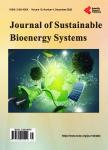Physicomechanical Properties of Sustainable Wood Plastic Composites of Tropical Sawdust and Thermoplastic Waste for Possible Utilization in the Wood Industry
Physicomechanical Properties of Sustainable Wood Plastic Composites of Tropical Sawdust and Thermoplastic Waste for Possible Utilization in the Wood Industry作者机构:Department of Pure and Industrial Chemistry Nnamdi Azikiwe University Awka Nigeria Department of Pure and Industrial Chemistry Chukwuemeka Odumegwu Ojukwu University Uli Nigeria
出 版 物:《Journal of Sustainable Bioenergy Systems》 (可持续生物质能源系统(英文))
年 卷 期:2023年第13卷第4期
页 面:149-171页
学科分类:08[工学] 0805[工学-材料科学与工程(可授工学、理学学位)] 080502[工学-材料学]
主 题:Wood Plastic Composites Density Water Absorption Capacity Cellulose Sustainability Recycle Waste
摘 要:This work investigated and quantified the physicomechanical properties of flat-pressed wood plastic composites produced with recycled polyethylene terephthalate, recycled polyethylene and sawdust derived from selected tropical timbers, namely, Nauclea diderrichii, Brachystegia eurycoma, Erythrophleum suaveolens and Prosopis africana, for possible utilization in the wood industry. The compounding of the polymer blends of the precursor plastics, namely recycled PET (rPET) and recycled PE (rPE) with the sawdust (SD) from the selected timbers to produce the desired wood rPET/rPE composites was carried out via the flat press method. The characterization of the physicomechanical properties of the wood plastic composites (WPCs) produced, such as the density, hardness, flexural strength, ultimate tensile strength, elongation %, thickness swelling and water absorption capacity was carried out using methods based mainly on the European Committee for Standardization (CEN) and the American Society for Testing Materials (ASTM) standards. The results of the investigation on the resultant composites indicated that changes in the SD content affected the density of flat-pressed WPCs in line with literature. Generally, it was observed that as wood dust increased and PET content decreased, the density of composites decreased with some deviations as expected probably due to the anisotropic nature of the wood fillers. The analysis of variance (ANOVA) revealed that there was a statistically significant variation in the wood composites of Nuclea diderichii based on the physicomechanical values as the p-value (0.020) obtained was less than the critical level of α = 0.05. It was also observed that the composite, Wood 1 Sample 5 (W1S5) which was composed of 40% rPE, 40% rPET and 20% SD (derived from Nuclea diderichii), had the highest percentage elongation (26.84%);the highest flexural strength (14.995 N/mm2) and possibly the least carbon footprint in the env



